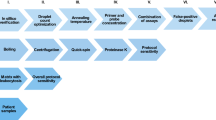Abstract
Diagnosis of neuroborreliosis is often difficult since history and clinical presentation may be non-specific and serological tests may initially be negative. We therefore tested the polymerase chain reaction (PCR) for the detection of borrelial sequences in CSF and urine samples of consecutive children with neuroborreliosis seen in a single summer season. Four of eight children were negative in serum for antibodies toBorrelia burgdorferi. Two of eight children were PCR-positive in CSF and one other child was positive in urine. In two out of four children PCR was the only laboratory test confirming the clinical diagnosis. All children recovered after treatment with third generation cephalosporins. When seven of eight children were re-examined 6 months later all were healthy and antibodies toB. burgdorferi were detected in their serum. PCR may assist the paediatrician in establishing a diagnosis of neuroborreliosis; however, a negative result does not rule out neuroborreliosis. PCR is an adjunct, but no substitute for clinical judgement and serology.
Similar content being viewed by others
Abbreviations
- PCR:
-
polymerase chain reaction
References
Cann KJ, Wright DJM (1992) Conference: Lyme disease. Lancet 339:1598
Christen HJ, Bartlau N, Hanefeld F, Thomssen R (1989) Lyme-Borreliose — häufigste Ursache der akuten peripheren Fazialisparese im Kindesalter. Monatsschr Kinderheilk 137: 151–157
Gassmann GS, Kramer M, Göbel UB, Wallich R (1989) Nucleotide sequence of a gene encoding theBorrelia burgdorferi flagellin. Nucleic Acids Res 17:3590
Gassmann GS, Jacobs E, Deutzmann R, Göbel UB (1991) Analysis of the Borrelia burgdorferi GeHo fla gene and antigen characterisation of its gene product. J Bacteriol 173:1452–1459
Goodman JL, Jurkovich P, Kramber JM, Johnson RC (1991) Molecular detection of persistentBorrelia burgdorferi in the urine of patients with active Lyme disease. Infect Immun 59: 269–278
Hansen K, Hindersson P, Pedersen NS (1988) Measurement of antibodies to theBorrelia burgdorferi flagellum improves serodiagnosis in Lyme disease. J Clin Microbiol 26:338–346
Hopf HC, Stroux B (1967) Die geographische Verteilung der Akrodermatitis chronica atrophicans (Herxheimer) in der Umgebung von Würzburg. Z Hautkr Geschlkr 43:41–48
Huppertz HI (1990) Childhood Lyme borreliosis in Europe. Eur J Pediatr 149:814–821
Huppertz HI, Karch H (1991) Die Lyme-Arthritis im Kindesalter: Monarthritis des Kniegelenks, klinisch nicht unterscheidbar von Monarthritiden unbekannter Ursache. Monatsschr Kinderheilkd 139:759–764
Huppertz HI, Sticht-Groh V (1989) Meningitis due toBorrelia burgdorferi in the initial stage of Lyme disease. Eur J Pediatr 148:428–430
Huppertz HI, Sticht-Groh V, Schwan T (1986) Borderline antibody response in initial stages of lymphocytic meningitis does not rule out borreliosis. Lancet II:1468–1469
Jaulhac B, Nicolini P, Piemont Y, Monteil H (1991) Detection ofBorrelia burgdorferi in cerebrospinal fluid of patients with Lyme borreliosis. N Engl J Med 326:1440
Krüger WH, Pulz M (1991) Detection ofBorrelia burgdorferi in cerebrospinal fluid by the polymerase chain reaction. J Med Microbiol 35:98–102
Kwok S, Higuchi R (1989) Avoiding false positives with PCR. Nature 339:237–238
Lebech AM, Hansen K (1992) Detection ofBorrelia burgdorferi DNA in urine samples and cerebrospinal fluid samples from patients with early and late Lyme neuroborreliosis by polymerase chain reaction. J Clin Microbiol 30:1646–1653
Malawista SE, Schoen RT, Moore TL, Dodge DE, White TJ, Persing DH (1992) Failure of multitarget detection ofBorrelia burgdorferi-associated DNA sequences in synovial fluid of patients with juvenile rheumatoid arthritis: a cautionary note. Arthritis Rheuma 35:246–247
Millner M, Schimek MG, Spork D, Schnizer M, Stanek G (1989) Lyme borreliosis in children. Eur J Pediatr 148:527–530
Rosa PA, Schwan TG (1989) A specific and sensitive assay for the Lyme disease spirocheteBorrelia burgdorferi using the polymerase chain reaction. J Infect Dis 160:1018–1029
Schmidt-Wolf I, Sticht-Groh V (1989) Zur Lyme-Krankheit, Teil 2: Elisa/IFT. Ärztl Lab 35:153–164
Wilske B, Schierz G, Preac-Mursic V, von Busch K, Kühlbeck R, Pfister HW, Einhäupl K (1986) Intrathecal production of specific antibodies againstBorrelia burgdorferi in patients with lymphocytic meningoradiculitis. J Infect Dis 153:304–314
Author information
Authors and Affiliations
Rights and permissions
About this article
Cite this article
Huppertz, H.I., Schmidt, H. & Karch, H. Detection ofBorrelia burgdorferi by nested polymerase chain reaction in cerebrospinal fluid and urine of children with neuroborreliosis. Eur J Pediatr 152, 414–417 (1993). https://doi.org/10.1007/BF01955900
Received:
Accepted:
Issue Date:
DOI: https://doi.org/10.1007/BF01955900




